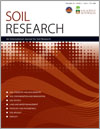SR15167Soil inorganic carbon in Pampean agroecosystems: distribution and relationships with soil properties in Buenos Aires province
Soil inorganic carbon (SIC) in landscape positions and related edaphic properties under agronomic uses in Pampean agroecosystems were examined. The following were determined: SIC relations with soil taxa, soil organic carbon effects on SIC content, and SIC distribution in soil horizons at great group level. SIC as a predictor of landscape use changes in agroecosystems.




